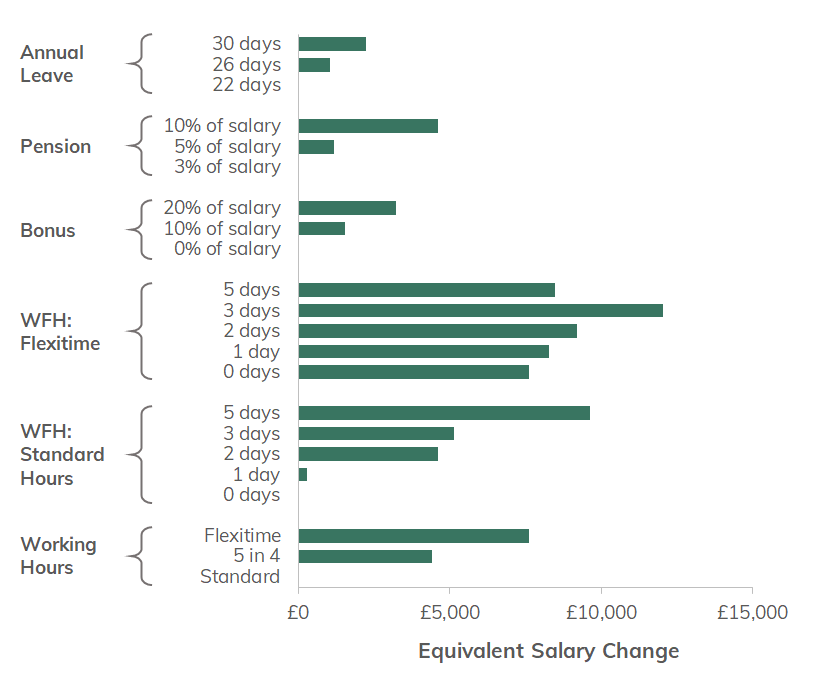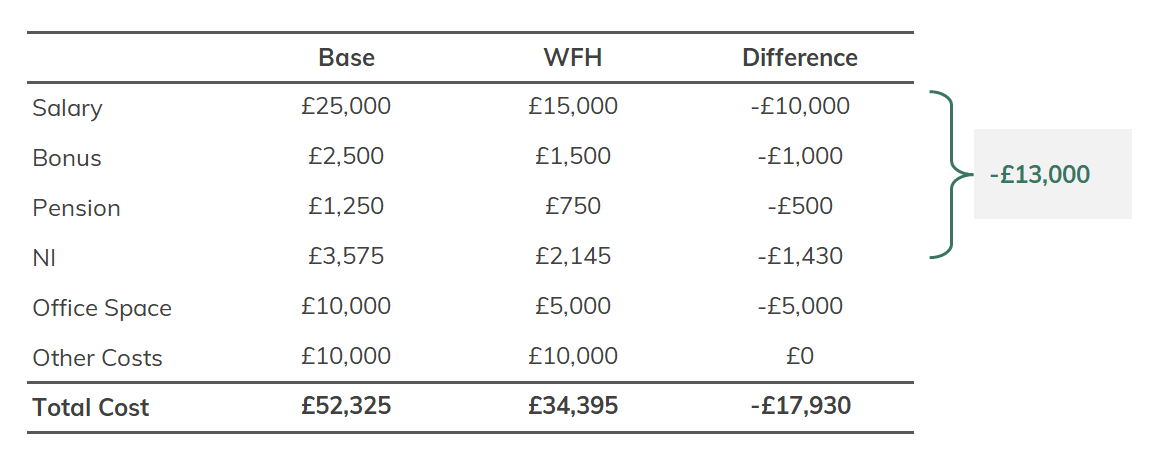The Compelling Economics of Working From Home
Posted: 16/09/2021


People’s strong preference is for flexible hours and the option to work from home three days a week. Based on a behavioural experiment, we find that they are willing to forgo up to 45% of their salary in exchange for this benefit. Hence, the compensation saving from offering a WFH package is about triple the direct saving in rent. This powerful business case means that WFH will remain widespread and become permanent. And by extension, 40% of UK office space needs to be re-purposed.
With the pandemic receding in the UK, people are starting to return to their offices and reflect on how Covid-19 has changed their work behaviours. The mass adoption of working from home (WFH) full-time within a matter of months would have seemed absurd in late 2019. But having surmounted those challenges, we have been left to the question the value of offices and how much time we want to spend in them.
From a commercial perspective, the WFH discussion has centred on contrasting its negative effects on productivity and revenues against its positive impacts on time-saving and office costs. But this analysis fails to account for employees’ own preference and, crucially, its influence on staff retention or, equivalently, compensation. In this article we seek to redress this gap by valuing different employment benefits, including WFH.
We studied this question using an immersive randomised controlled trial. 1,300 nationally representative participants were asked to pick between two full-time job offers constructed at random using the features detailed in Figure 1 and varying base salaries. Modelling this data measures how people trade-off between these benefits and base salary. For example, the figure shows that migrating from 22 days holiday (plus bank holidays) to 30 days has the same impact on job attractiveness as raising salary by £2.2k from £15.0k to £17.2k.
Figure 1: The Value of Employment Benefits

The respondents demonstrated some surprisingly rational behaviours. For instance, a 20% increase in bonus is equivalent to +£3.2k increase in salary, or +21% up on the £15k baseline. Likewise, a 7% increase in employer pension contribution is worth more than a 7% increase in bonus. This is directionally correct given the tax advantages of pensions.
But the most interesting insights concern working hours and WFH. First, people have a strong preference for Flexitime (and to a lesser extent compressed hours where you work your 5-day week in 4 days). Second, they are willing to forgo a substantial amount of salary to have the option of WFH. We find that being able to work 5 days from home is equivalent to a +£9.6k (+64%) increase in salary.
And crucially, there appears to be an interaction between these two benefits. If people are offered Flexitime, then the value of WFH lessens and people start to actively prefer three days at home, since they no longer need all the freedom associated with five. This means you can simultaneously maximise the WFH employment benefit whilst still retaining enough office face-time to navigate the downsides of completely remote working.
Figure 2: Example Financial Impact

Assumptions: Scenario has 10% bonus, 5% pension contribution and NI of 13%. Office costs and other overheads are 20% of overall employee costs respectively.
We believe that this finding has profound implications for the future of office work and its longer-term repercussions for the amount of space required by the UK economy. Figure 2 illustrates this point. In the WFH condition, an employee is paid £15k with various benefits, including Flexitime and 3-day WFH. In the Office condition, these two benefits are removed and the employee is paid an additional £10k in order to make the job equally attractive and, by implication, attract the same calibre candidates.
The traditional Office condition pays the full £25k salary and provides an office for around 20% of the all-in employee cost of £52k. The WFH condition halves this office cost, saving £5k but also provides for a substantial salary reduction. Once that’s amplified by bonus, pension and NI payments the saving is £13k, nearly twice the visible real estate cost reduction.
The economic case in favour of WFH post-pandemic isn’t about saving office costs. Three quarters of the savings materialise as lower payroll or, equivalently, higher staff retention. And the scale of these savings will surely outweigh the negatives once they are mitigated by 2-days per week in-person. 3-day WFH is here to stay. Businesses need to find ways to maximise productivity under that constraint and co-ordinate office time to minimise the real estate requirement. Meanwhile, this new reality isn’t yet priced into the office market. Sell.